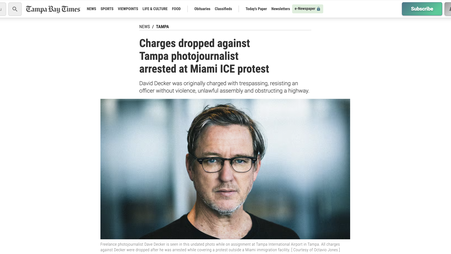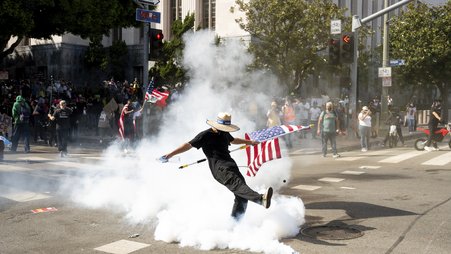
The outrageous raid of the Marion County Record got plenty of coverage. But it's far from the only noteworthy recent press freedom violation.
The Aug. 11 police raid in Marion, Kansas, shocked the nation — and rightfully so. It was a uniquely egregious assault on the press and it might have actually killed someone.
The raid was outrageous, its aftermath tragic. Still, it was heartening to see the media focused on press freedom. Hopefully that continues. But here are ten other ongoing violations of journalists’ rights that, unlike Marion, are not getting the coverage they deserve.
The other raid: The FBI raided Tim Burke’s home in May after he published outtakes of Tucker Carlson’s interview with Kanye West, which Burke says he found on a public website. The government hasn’t explained how he broke the law. And in court papers this month, it questioned whether he’s entitled to protections for journalists. That’s worrisome, especially coming from the same Department of Justice prosecuting Julian Assange. Burke, like Assange, published information of public interest. That’s journalism and it’s protected by the First Amendment, regardless of whether they work for established outlets. And if the raid proves as baseless as the one in Marion, it deserves the same condemnation.
California clawback: The City of Los Angeles sued journalist Ben Camacho to get back photographs of undercover cops it inadvertently provided to him. One problem: The Supreme Court has held repeatedly that once the government releases records, even accidentally, it cannot claw them back nor restrain publication. But Judge Anthony Mohr ignored the law and let the lawsuit proceed. Why he thinks police secrecy is the exception to the rule against “prior restraints” is anyone’s guess.
Silenced in St. Louis: In May, Judge Elizabeth Hogan barred the St. Louis Post-Dispatch from publishing information it obtained from a court website. Three months and several continuances later, the paper is still barred from publishing. Hogan held a hearing last week only to kick the can down the road again. Even if she withdraws her unconstitutional order, the damage is done. As the Supreme Court explained, "The loss of First Amendment freedoms, for even minimal periods of time, unquestionably constitutes irreparable injury."
Gagged in Greensboro: The Supreme Court has also held that judges who allow journalists into juvenile courts can’t stop them from publishing what they hear. But Judge Ashley Watlington-Simms in Greensboro, North Carolina, nonetheless barred journalist Kenwyn Caranna from covering a hearing she was allowed to attend, even seizing her notes. Most reporters carefully consider privacy concerns when covering minors. But that’s a decision for journalists — not judges. Judicial seizures of reporters’ notes should never happen in this country.
Censorious SLAPPs: In contrast to Marion, where a restauranteur’s complaint prompted a newsroom raid, the more common playbook for the powerful is drowning critics in legal fees from strategic lawsuits against public participation, or SLAPPS. The New York Times recently wrote about a Wisconsin state senator’s abusive lawsuit and appeal over an article reporting he used a homophobic slur. The ordeal has cost the nonprofit news outlet he sued almost $150,000 so far and may put it out of business.
Prosecuting photography: Photojournalist Stephanie Keith was arrested in May for photographing a vigil for Jordan Neely. This month, prosecutors agreed to an “adjournment in contemplation of dismissal.” That basically means they’ll dismiss the case as long as Keith behaves for the next six months. We understand why Keith would accept that deal rather than waste time fighting baseless charges. But what message does it send when, to avoid prosecution, authorities force a journalist to promise not to … do what exactly? Take pictures?
Ohio’s intimidation tactics: Ohio journalist Derek Myers was charged last year with wiretapping for publishing a source’s recordings from a murder trial. Prosecutors, rather than embarrass themselves in court (the Supreme Court has held journalists are not responsible for sources’ illegal recordings), let their deadline to pursue the case expire this month. As we’ve said, “Officials don’t file these kinds of cases to win but to intimidate.”
Confidentiality undermined: Federal Judge Christopher Cooper ordered journalist Catherine Herridge to identify confidential sources this month. She’s appealing. As we told CNN, “Requiring journalists to reveal their confidential sources deters whistleblowers and others from coming forward.” The case underscores the need for the bipartisan PRESS Act “to make clear that reporters can’t be forced to burn their source.”
Lawmakers play editor: Two legislators — including one known for toting guns in front of Christmas trees — introduced a resolution that condemned “irresponsible and sensationalistic” coverage of mass shootings and then made unsolicited “recommendations” to the press. Ironically, those behind the resolution have previously insisted government attempts to influence content are illegal censorship. They should practice what they preach — Americans don’t elect representatives to tell journalists how to do their jobs.
Kansas code of silence: Back in Marion, Record publisher Eric Meyer says the paper investigated why Police Chief Gideon Cody left his prior job in Kansas City before orchestrating the raid. The Kansas City Star reports Cody was under disciplinary review, but police won’t release complaints against him, citing open records exceptions for documents generated during investigations. Obviously, the complaints predate any investigation. It’s the latest abuse of investigative exceptions to open records laws. Marion residents deserve to know the truth about the chief who brought “Hitler tactics” to their town of 1,902.
What can be done
In the Record’s case, Meyer says the paper may sue, and victims of anti-press antics should do so whenever possible. Journalist Bryan Carmody settled for almost $400,000 after San Francisco police raided his home in 2019. Oakland journalist Timothy Ryan also recently settled for $400,000 after he was injured by police in 2020. Settlements like those not only compensate journalists for damages but force officials to think twice about retaliating against the press.
But Marion shows that journalists cannot rely solely on the legal system for recourse — many press freedom violations are perpetrated or enabled by a judiciary that clearly needs a refresher on the First Amendment. Until then, journalists and others should continue calling attention to abuses. Perhaps the court of public opinion will better serve the press than a court of law.




